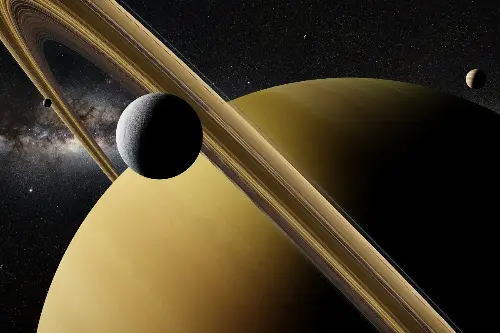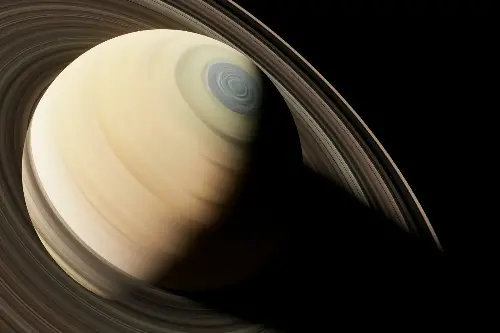A celestial spectacle like no other, Saturn has long captivated the imaginations of astronomers and space enthusiasts alike. With its majestic rings and air of mystery, it stands as a titan amongst the cosmic gallery of planets in our Solar System. Here, we'll delve into some of the most fascinating aspects of Saturn, exploring what makes this gas giant a wonder to behold and a treasure trove of astronomical intrigue.

Saturn's Grand Rings: A Dance of Ice and Rock
Perhaps the most striking feature of Saturn is its intricate ring system, an expansive disc composed primarily of ice particles with a smattering of rocky debris and dust. While all of the gas giants in our Solar System boast rings, none are as extensive or as bright as Saturn's. Astonishingly, though they span up to 282,000 kilometres across, the rings are relatively thin—some parts are only about 10 meters thick.
Recent research has suggested that these icy structures might be remnants of comets, asteroids, or even moons that were torn apart by Saturn's immense gravitational force. The rings are segmented into seven distinct parts, each with its own characteristics and named alphabetically in the order of their discovery: from the dim D ring, closest to the planet, out to the second-brightest A ring, followed by the F, G, and E rings.
A Planet of Extremes: Saturn's Weather and Atmosphere
Beneath the rings lies the planet itself, a gas giant composed predominantly of hydrogen and helium. Saturn's atmosphere is home to some of the Solar System's most extreme weather conditions. The winds here can reach speeds of up to 1,800 kilometres per hour, far exceeding Earth's most ferocious hurricanes. The planet also exhibits long-lasting storms, like the Great White Spot—a tempest so large that it can be seen from Earth.
In 2010, the Cassini spacecraft observed an enormous storm on Saturn that raged for over 200 days, highlighting the planet's dynamic and tempestuous nature. This weather is driven by the rapid rotation of the planet and the heat from its interior, creating a turbulent and volatile atmosphere.

The Many Moons of Saturn: A Family of Worlds
Saturn's influence extends far beyond its rings; it is a guardian to a fascinating family of moons – 82 confirmed, with perhaps still more waiting to be discovered. These satellites range from tiny moonlets to the colossal Titan, which is even larger than the planet Mercury. Titan stands out among the moonlit crowd with its dense atmosphere and liquid hydrocarbon lakes, making it one of the most Earth-like bodies and a prime target for future exploration.
Enceladus, another of Saturn's moons, intrigues scientists with its icy surface and geysers that spout water vapour and organic compounds, hinting at a subsurface ocean. These geysers are thought to supply particles to one of Saturn's outermost rings, the E ring, showcasing an intricate connection between the planet and its moons.
Saturn's Mysteries: The Hexagon and its Secrets
At Saturn's north pole, a bizarre six-sided jet stream known as 'the hexagon' encircles the pole, and within it rages a massive hurricane with an eye measuring 50 times larger than the average hurricane eye on Earth. First observed by the Voyager spacecraft in the early 1980s and later studied by the Cassini mission, this peculiar feature remains one of the most compelling natural phenomena in our Solar System, with the exact mechanism behind its geometry still not fully understood.

Cassini's Legacy: Unravelling Saturn's Mysteries
The Cassini mission, a collaborative project between NASA, the European Space Agency, and the Italian Space Agency, has vastly increased our understanding of Saturn and its celestial family. Launched in 1997, Cassini arrived at Saturn in 2004 and spent 13 years exploring the planet's system before its deliberate descent into the planet in 2017.
Cassini's treasure trove of data continues to inform and inspire. Its findings have reshaped our understanding of planetary formation, while its detailed pictures have brought Saturn's beauty directly to the public eye.
The Cultural Impact: Saturn Through the Ages
Beyond the realm of science, Saturn has held a significant place in various cultures throughout history. Known to the ancient Romans as the god of agriculture and wealth, the planet's name has remained entrenched within the mythology and astrology that followed. Saturn's visibility to the naked eye and its peculiar appearance have made it a figure of curiosity and speculation for millennia.
In contemporary culture, Saturn's imagery often symbolises mystery, remoteness, and the exotic nature of outer space. It continues to inspire artistic and literary works, as well as playing a prominent role in modern astronomy and space exploration discussions.
In conclusion, Saturn is an emblem of the wonders that exist within our universe. It is a planet that, despite its distance from Earth, has a far-reaching influence not only on the scientific community but also on our collective imaginations. From the ethereal dance of its rings to the enigma of its polar hexagon, Saturn invites us to gaze skyward and ponder the majesty that resides within our cosmic neighbourhood. The mysteries of the ringed planet remain many, and the wonder it inspires is as boundless as the swirling gases in its upper atmosphere. Each discovery made about Saturn offers a new piece to the ever-expanding puzzle of our Solar System's secrets, solidifying its place as one of the most visually captivating and scientifically intriguing celestial spectacles we have the privilege of observing.
